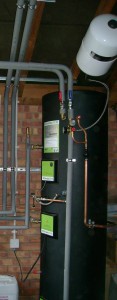Another way to capture the sun’s energy is solar thermal, to heat water. We had a solar thermal collector installed on the south facing extension roof, connected to a hot water tank in the garage. Unfortunately this area of roof has a shadow of the main house which begins to move over it from 16:30. However, as we decided to use all the main roof for PV this was the next best location. This kind of decision is an example of a compromise that has to made in retro-fitting a less than ideal property.
Solar Thermal
-
Product Solfex Ritter CPC12 – 12 evacuated tubes Rating 2m2 aperture, expected yield 1300 units per year
about half our hot water needsCost £4,500 Saving £90 + 0.4 tonnes CO2 per year RHI Income £250 a year for 7 years Payback time 30 years Supplier Pure Renewables
Even in cold, hazy weather it gently heats the cold water that enters the bottom of the hot water tank every time we turn on a hot tap. On hot, sunny days it brings the whole tank up to a piping hot 65˚C.
 Solar Thermal is relatively simple – a radiator painted black and placed in the sun will heat water flowing through it. Ours is rather more optimised, but uses the same general principle. But the long glass tubes aren’t full of liquid. The circulating liquid (an antifreeze) flows through the top collecting heat from metal plates in the tubes.
Solar Thermal is relatively simple – a radiator painted black and placed in the sun will heat water flowing through it. Ours is rather more optimised, but uses the same general principle. But the long glass tubes aren’t full of liquid. The circulating liquid (an antifreeze) flows through the top collecting heat from metal plates in the tubes.
The tubes are evacuated to reduce heat loss, just like the vacuum flask for your tea. The metal plates inside the tubes contain a liquid that absorbs heat from the sun and evaporates into a gas; at the top the gas gives up this heat into the circulating antifreeze and condenses back into a liquid. (This ‘liquid -> gas -> liquid’ phase change cycle is crucial in how the heat pump works too.)
 We have an insulated 300 litre hot water tank in the garage with 2 coils in it.
We have an insulated 300 litre hot water tank in the garage with 2 coils in it.
Hot liquid from the solar thermal flows through the lower coil, and heats the whole tank on sunny days.
The upper coil is connected to the heat pump which will kick in at night to top up the tank if it isn’t hot enough. By running only at night it gives the solar thermal time to work during the day. If it needs to run at all it will only use off peak electricity, when power stations are still hot & wind turbines are turning, but electricity demand is low.
Renewable Heat Incentive
The Renewable Heat Incentive (RHI) is a government scheme that makes payments for generating renewable heat… it closed in 2022.